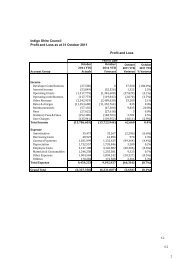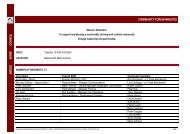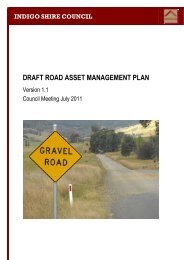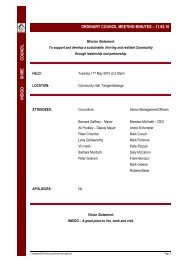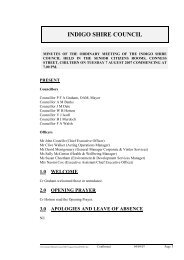Indigo Shire - renewable energy mapping - Indigo Shire Council
Indigo Shire - renewable energy mapping - Indigo Shire Council
Indigo Shire - renewable energy mapping - Indigo Shire Council
Create successful ePaper yourself
Turn your PDF publications into a flip-book with our unique Google optimized e-Paper software.
Earth Systems<br />
Mapping and Brokering Local Energy Solutions in <strong>Indigo</strong> <strong>Shire</strong><br />
WO<br />
WOTS<br />
ZSS<br />
Wodonga (Substation)<br />
Wodonga Terminal Substation<br />
Zone Substation<br />
Glossary of Terms<br />
Availability Factor<br />
Capacity Factor<br />
Direct solar exposure or<br />
DNI (Direct Normal<br />
Irradiance)<br />
Distributed Generation<br />
Efficiency<br />
Global solar exposure or<br />
GHI (Global Horizontal<br />
Irradiance)<br />
Hub height<br />
Internal Rate of Return<br />
Land use factor<br />
Levelised Cost of Energy<br />
Availability factor indicates how much of the time the plant is available to<br />
meet demand.<br />
The net capacity factor of a power plant is the ratio of the actual output<br />
of a power plant over a period of time and its potential output if it had<br />
operated at full nameplate capacity the entire time.<br />
Solar direct normal irradiance (DNI) is the instantaneous intensity of<br />
solar direct beam <strong>energy</strong> falling on a surface normal to the beam.<br />
Distributed generation involves the technology of using small-scale<br />
power generation technologies located in close proximity to the load<br />
being served.<br />
A ratio of yielded output per unit input for a specific process, normally<br />
expressed as a percentage.<br />
GHI is the instantaneous intensity of solar <strong>energy</strong> falling on a horizontal<br />
surface. The values are usually highest in the middle of the day and<br />
around summer, with localised variations caused mainly by variations in<br />
atmospheric conditions, primarily cloudiness.<br />
Specific to wind <strong>energy</strong>, it is the distance from the turbine platform to the<br />
rotor of an installed wind turbine and indicates how high the turbine<br />
stands above the ground, not including the length of the turbine blades<br />
The discount rate often used in capital budgeting that makes the net<br />
present value of all cash flows from a particular project equal to zero<br />
The land use factor is the ratio between the directly utilised ground area<br />
of a technology deployment and the total land area required for<br />
deployment, including necessary redundant land area, such as that<br />
required between solar thermal mirrors to avoid shading issues.<br />
A present value measure of the lifecycle cost of generating power from a<br />
given plant considering the capital cost, operating costs (including fuel),<br />
capacity factor, financing cost, and incentives. The Levelised Cost is a<br />
useful calculation because it allows comparison of different generation<br />
technologies on an equal basis.<br />
ISC1240_Phase_1_Report_Rev0_public report 19









